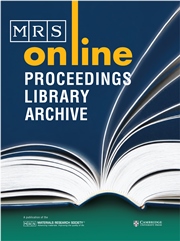No CrossRef data available.
Article contents
Using Convective Flow Splitting for the Direct Printing of Fine Copper Lines
Published online by Cambridge University Press: 10 February 2011
Abstract
We have developed a technique for the printing of copper lines using solutions of a metal organic precursor, copper hexanoate. A 500-µm written liquid line is observed to split into two 100-µm wide lines. We observe further splitting into four parallel lines in experiments with written lines of copper hexanoate solution in chloroform. Surface profiles indicate that the thickness, width and number of lines formed are strongly dependent on the solution viscosity and volume per unit length deposited. From particle tracking visualization and surface profiling, we have found that evaporative cooling produces Marangoni convection patterns that accrete the solute along two key boundaries of flow
Information
- Type
- Research Article
- Information
- Copyright
- Copyright © Materials Research Society 2000

